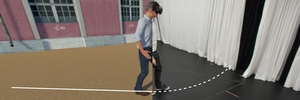Information
- Publication Type: Conference Paper
- Workgroup(s)/Project(s):
- Date: March 2020
- ISBN: 978-1-7281-6532-5
- Publisher: IEEE
- Location: Atlanta, US
- ISSN: 978-1-7281-6533-2
- Event: IEEEVR 2020
- DOI: 10.1109/VRW50115.2020.00032
- Call for Papers: Call for Paper
- Booktitle: 2020 IEEE Conference on Virtual Reality and 3D User Interfaces Abstractsand Workshops (VRW)
- Pages: 154-159
- Pages: 154 – 159
- Keywords: redirected walking, body representation, curvature gain, translation gain
Abstract
Redirected Walking (RDW) techniques allow users to navigate immersive virtual environments much larger than the available tracking space by natural walking. Whereas several approaches exist, numerous RDW techniques operate by applying gains of different types to the user’s viewport. These gains must remain undetected by the user in order for a RDW technique to support plausible navigation within a virtual environment. The present paper explores the relationship between detection thresholds of redirection gains and the presence of a self-avatar within the virtual environment. In four psychophysical experiments we estimated the thresholds of curvature and translation gain with and without a virtual body. The goal was to evaluate whether a full-body representation has an impact on the detection thresholds of these gains. The results indicate that although the presence of a virtual body does not significantly affect the detectability of these gains, it supports users with the illusion of easier detection. We discuss the possibility of a future combination of full-body representations and redirected walking and if these findings influence the implementation of large virtual environments with immersive virtual body representation.Additional Files and Images
Weblinks
BibTeX
@inproceedings{reimer-2020-CBG,
title = "The Influence of Full-Body Representation on Translation and
CurvatureGain",
author = "Dennis Reimer and Eike Langbehn and Hannes Kaufmann and
Daniel Scherzer",
year = "2020",
abstract = "Redirected Walking (RDW) techniques allow users to navigate
immersive virtual environments much larger than the
available tracking space by natural walking. Whereas several
approaches exist, numerous RDW techniques operate by
applying gains of different types to the user’s viewport.
These gains must remain undetected by the user in order for
a RDW technique to support plausible navigation within a
virtual environment. The present paper explores the
relationship between detection thresholds of redirection
gains and the presence of a self-avatar within the virtual
environment. In four psychophysical experiments we estimated
the thresholds of curvature and translation gain with and
without a virtual body. The goal was to evaluate whether a
full-body representation has an impact on the detection
thresholds of these gains. The results indicate that
although the presence of a virtual body does not
significantly affect the detectability of these gains, it
supports users with the illusion of easier detection. We
discuss the possibility of a future combination of full-body
representations and redirected walking and if these findings
influence the implementation of large virtual environments
with immersive virtual body representation.",
month = mar,
isbn = "978-1-7281-6532-5",
publisher = "IEEE",
location = "Atlanta, US",
issn = "978-1-7281-6533-2",
event = "IEEEVR 2020",
doi = "10.1109/VRW50115.2020.00032",
booktitle = "2020 IEEE Conference on Virtual Reality and 3D User
Interfaces Abstractsand Workshops (VRW)",
pages = "154-159",
pages = "154--159",
keywords = "redirected walking, body representation, curvature gain,
translation gain",
URL = "https://www.cg.tuwien.ac.at/research/publications/2020/reimer-2020-CBG/",
}


